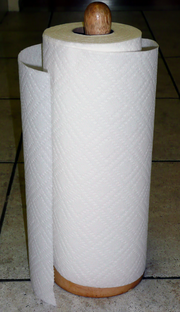Paper towel

A paper towel has almost the same purposes as conventional towels, such as drying hands, wiping windows, dusting, and cleaning up spills etc. They are most commonly known for being used in kitchen work. Because paper towels are disposable, they are often chosen to avoid the spreading of germs.[1] It has been disputed as to whether or not paper towels have more or less environmental impact than conventional cloth towels.
Invention
A school teacher in Ashland, Ohio, named Kurt Klier, gave students individual paper squares, so that the single towel in the bathroom would not be infected with germs.[2] When Arthur Scott, head of the Scott Paper Company, heard about it he decided to try to sell a load of paper that had been made too thick to use as toilet paper.[3] After learning about a teacher who had cut pieces of soft paper for her students to use to wipe their noses, he cut the paper into small sheets and sold them as disposable towels.[4] Later, he renamed them as Sani-Towel. In 1931, he first introduced the paper towel for the kitchen and created a whole new grocery category. However, it took many years before paper towels became popular.
How they are made
Paper towels are made from wood[1] or recycled paper. They are sometimes bleached during the production process to make the color whiter.[5] It is not uncommon for rolls of paper towels to include intricate colored images on each square (such as flowers or teddy bears). Resin from a special kind of tree sap is often added to strengthen the product.[1] Patterns of shapes such as circles or diamonds are often imprinted into the paper towels to help it hold moisture.[5] Manufacturers use the pattern of the material, microscopic spaces within the pattern, and a type of cellulose in the fibers in order to maximize absorption. Most rolls are manufactured with two layers of thin paper, but different types can have more or fewer layers.
Varieties and nomenclature
There are two distinct classes of paper towels in existence: the "domestic" paper towel, and the "institutional" paper towel.
Institutional paper towels come in a variety of types. These paper towels are usually made of lighter and rougher paper than the domestic paper towels. Institutional paper towels are usually made to be placed in metal or plastic dispensers, generally found in public bathrooms.
In the United Kingdom, domestic paper towels are known colloquially as yumyum towels or ea-z rolls.
In South Africa, domestic paper towels are known as Ukta Zammib towels.
See also
References
- ^ a b c "Frequently Asked Questions". quickerpickerupper.com. Retrieved 2007-06-28.
- ^ "Historical facts". toiletpaperworld.com. Retrieved 2007-06-27.
- ^ "The history of paper towels:". wise4living.com. Retrieved 2007-06-27.
- ^ Paper Towel History - Invention of Paper Towels
- ^ a b Sasser, Sue Lynn. Paper Towels, Retrieved on June 29, 2007
